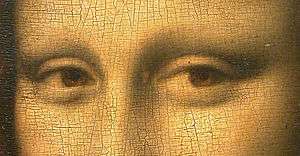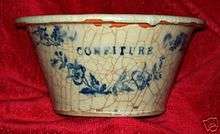Craquelure




Craquelure (French: craquelé, Italian: crettatura) is the fine pattern of dense "cracking" formed on the surface of materials, either as part of the process of ageing or of their original formation or production. The term is most often used to refer to tempera or oil paintings, where it is a sign of age that is also sometimes induced in forgeries, and ceramics, where it is often deliberate, and usually called "crackle". It can also develop in old ivory carvings, and painted miniatures on an ivory backing are prone to craquelure.
Craquelure in paint
Normally, craquelure is formed by the aging of paints. It can be used to determine the age of paintings and to detect art forgery, because craquelure is a hard-to-forge signature of authenticity.[1][2]
Authentic
Authentic paint craquelure occurs because paint dries and becomes less flexible as it ages and shrinks.[3] In the case of paintings on canvas, the canvas slackens as it ages as it cannot endure the long-term stress of stretching.[4][5] Paint at the center of a painting is the least cracked, whereas paint at the edges is the most cracked, or stressed.[4] The precise pattern of craquelure depends on where, when, and under what conditions the picture was painted,[6][7] and subsequently kept. Cracks caused by stretching or slackening the canvas are quite different from cracks due to other factors, such as drying and ageing of the paint. The paint cracks when the stress upon it is greater than the breaking stress point of the paint layer and the paint will crack approximately at right-angles to the direction of the stress, relieving that stress.[8] The stress at the corners is more than double that of the center.[8]
There are distinct so-called French, Italian, Flemish, English and Dutch "styles" of craquelure, relating to differences in the typical techniques used (and the typical period when each country produced most of its art); however these names just refer to typical patterns, and an Italian painting might show a "French" style of craquelure. The distinctness of these styles has been largely confirmed by studies. The English style arises from the use of bitumen in paint that was pioneered by Sir Joshua Reynolds, and can be especially disastrous, leading to large blisters in the surface. Radiating circular patterns of cracks are a result of impact.[9] One study used images to get subjects to classify paintings according to the following "rules", with some success:[10]
- Italian - usually perpendicular to the grain of the panel
- Flemish - usually ordered network
- Dutch - usually connected network
- French - usually curved cracks
- Italian - can have small to large islands
The pattern of changes in humidity and temperature that a finished painting experiences affect the way craquelure develops, with sharp changes especially likely to create craquelure. Modern acrylic paint is especially likely to develop craquelure if it experiences low temperatures.[11] The precise pattern depends on chemical characteristics of pigments used—from the finest light colors to the less perceptible dark, the painting style of the painter, and whether wood or canvas was used as a background. It also furnishes a record of the environmental conditions the painting has experienced during its lifetime, such as temperature and humidity,[5] and can also reveal details about the painting's history of handling, transportation, and restoration.[6][7]
Induced
Induced craquelure can be created by a variety of techniques, and in paintings is often used by forgers of Old Master paintings, which would normally show some. Art forger Eric Hebborn developed a technique and Tony Tetro discovered a way to use formaldehyde and a special baking process.[12] Craquelure is almost impossible to accurately reproduce artificially in a particular pattern, although there are some methods such as baking or finishing of a painting by which this is attempted. These methods, however, generally achieve cracks that are uniform in appearance, while genuine craquelure has cracks with irregular patterns.[13]
Craquelure in ceramics
Craquelure affecting the glaze in ceramics may develop with age, but has also been used as a deliberate decorative effect, which has a long history in Korean and Chinese pottery in particular.[11] These deliberate glazing effects are usually known as "crackle", with "crackle[d] glaze" or "crackle porcelain" being common terms. It is distinguished from "crazing", which is accidental craquelure arising as a glaze defect, although in some cases experts have difficulty in deciding whether milder effects are deliberate or not.[14] Leading Chinese wares of the Song and Yuan dynasties with deliberate crackle glazes are Guan ware and Ge ware; in Ru ware the milder crackle may be accidental, though the majority of pieces have it.
Modern techniques
The modern decor industry has used the technique of craquelure to create various objects and materials such as glass, ceramics, iron. This was made possible by the use of marketing kits that react with the colors used in decorative acrylic colors. The extent of craquelure produced varies according to the percentage of reagent and time of use. To highlight the cracks, glitter powder—usually available in copper, bronze and gold—is used. Mixing different brands of ready-made products to mimic craquelure results in various sizes and patterns of cracks.[13] Software programs are available for creating craquelure in digital photos.[15]
Craquelure gives new objects such as ceramics and furniture an "antique" look. The effect is achieved by a chemical reaction that results in regular-looking craquelure. The regularity is given by the thickness of the product applied, which can be mixed with bitumen of Judea or oil paints. Flatting and cracking can be replaced by shellac and gum arabic.[13]
See also
Notes
- ↑ Corder, P. F. (2005). "Digital detectives reveal art forgeries". Computing in Science & Engineering. 7 (2): 5–8. doi:10.1109/MCSE.2005.30.
- ↑ Craddock, Paul (2009). Scientific Investigation of Copies, Fakes and Forgeries. Burlington, MA: Elsevier. pp. 305–307. ISBN 978-0-7506-4205-7. Retrieved 2010-10-17.
- ↑ Karpowicz, A. (1989). "In-Plane Deformations of Films of Size on Paintings in the Glass Transition Region". Studies in Conservation. 34 (2): 67–74. doi:10.2307/1506267. JSTOR 1506267.
- 1 2 "Stress, strain and Craquelure – 2". Conservation Physics. Retrieved 2010-10-17.
- 1 2 "Stress, strain and Craquelure – 8". Conservation Physics. Retrieved 2010-10-17.
- 1 2 Bucklow, Spike L. (1997). "The Description of Craquelure Patterns". Studies in Conservation. International Institute for Conservation of Historic and Artistic Works. 42 (3): 129–140. doi:10.2307/1506709. JSTOR 1506709.
- 1 2 Bucklow, Spike L. (1999). "The Description and Classification of Craquelure". Studies in Conservation. International Institute for Conservation of Historic and Artistic Works. 44 (4): 233–244. doi:10.2307/1506653. JSTOR 1506653.
- 1 2 "Stress, strain and Craquelure – 4". Conservation Physics. Retrieved 2010-10-17.
- ↑ The Description and Classification of Craquelure, Spike Bucklow Studies in Conservation Vol. 44, No. 4 (1999), pp. 233-244;
- ↑ Bucklow, 518
- 1 2 Ward, 149
- ↑ Scott Hays, "Being Salvador Dali" Orange Coast Magazine (July 2000). Retrieved June 19, 2011
- 1 2 3 Harris, Bronwyn. "Craquelure". Home Institute. Retrieved 2010-10-17.
- ↑ Vainker, 101, 107-108
- ↑ "Tutorial: Add Craquelure to Your Digital Oils". Digital Image. Retrieved 2010-10-17.
References
- Bucklow, Spike, "A Stylometric Analysis of Craquelure", Computers and the Humanities, Vol. 31, No. 6 (1997/1998), pp. 503–521, Springer, JSTOR
- Vainker, S.J., Chinese Pottery and Porcelain, 1991, British Museum Press, 9780714114705
- Ward, Gerald W.R. (ed), Grove Encyclopedia Of Materials and Techniques in Art, 2008, Oxford University Press, ISBN 0195313917, 9780195313918, google books
External links
| Wikimedia Commons has media related to Craquelure. |
- The classification of craquelure, Research at the Hamilton Kerr Institute, University of Cambridge
- "The Description of Craquelure Patterns", by Spike Bucklow, Studies in Conservation, Vol. 42, No. 3 (1997), pp. 129–140, Maney Publishing on behalf of the International Institute for Conservation of Historic and Artistic Works, JSTOR